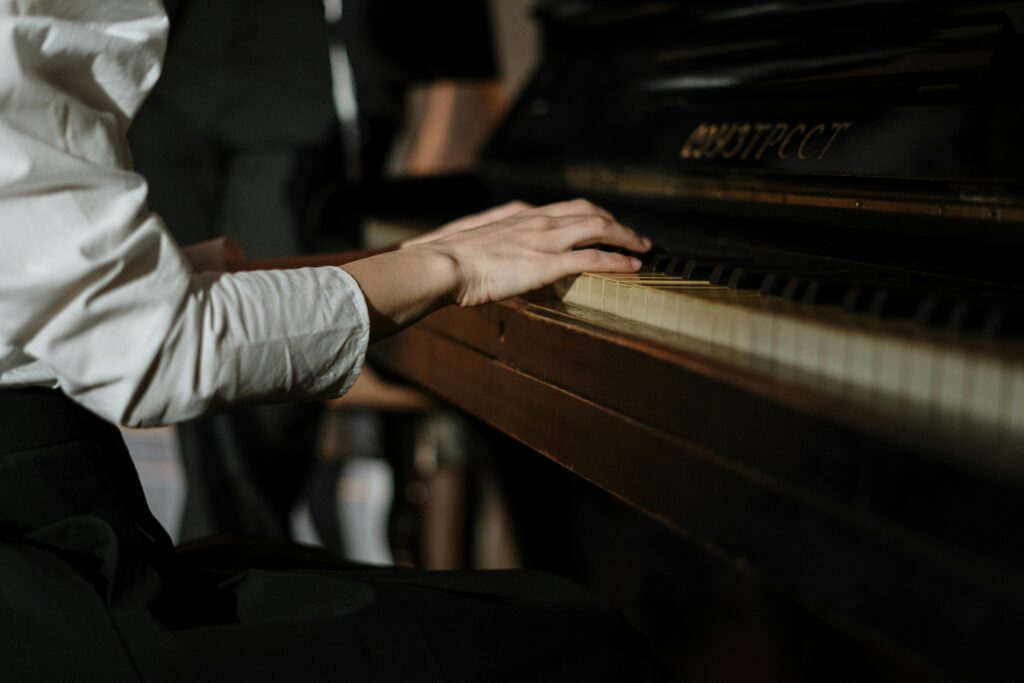György Ligeti is one of the most influential and innovative composers of the 20th century. His works continue to inspire and challenge musicians around the world. In particular, Ligeti’s piano etudes are among the most famous of his contributions. They are both technically demanding and artistically challenging.
Ligeti’s etudes are beyond dexterity exercises. They take their place in the pantheon of highly virtuosic etudes, extending from the influence of pianists like Chopin and Liszt and reflect Ligeti’s deep understanding of the piano and his desire to expand its possibilities. Let’s explore some of Ligeti’s best etudes.
- Fall in love with the music - Learn your favorite songs, at a level suitable for you.
- Enjoy interactive piano lessons - Explore courses covering music theory, technique chords & more.
- Get real-time feedback - Skoove's feedback tells you what went well and what needs practice.

What makes Ligeti’s etudes unique?
Ligeti’s piano etudes are a testament to his innovative spirit and his ability to weave together diverse musical influences into a cohesive and compelling whole. These etudes stand out in the piano repertoire for several reasons, each contributing to their status as some of the most challenging and rewarding pieces to play.
Complex rhythms and polyrhythms
One of the most distinctive features of Ligeti’s etudes is their complex rhythmic structure. Ligeti was fascinated by polyrhythms—the simultaneous use of contrasting rhythms—and this fascination is evident throughout his etudes.
The rhythmic complexity in these pieces is integral to the musical expression, creating a sense of tension and release that keeps both the performer and the listener engaged. For example, in his first etude, “Désordre,” Ligeti explores polyrhythms and time signatures with two hands playing at different speeds, creating a sense of controlled chaos that is both exhilarating and challenging to execute.
Innovative use of harmony and dissonance
Ligeti’s approach to harmony is another element that sets his etudes apart. He often employs unconventional harmonies and dissonance, moving away from traditional tonal structures to create a unique soundscape.
This use of dissonance is not arbitrary; it is carefully crafted to evoke specific emotions and atmospheres, adding depth and complexity to the music. In his etudes, Ligeti often juxtaposes consonant and dissonant harmonies, creating a rich tapestry of sound that challenges the listener’s expectations and invites deeper exploration.
Extended piano techniques
Ligeti’s etudes also require pianists to use extended techniques, pushing the boundaries of traditional piano techniques. These techniques might include playing inside the piano, using unconventional fingerings, or employing unusual pedal techniques.
These demands not only test a pianist’s technical ability but also their creativity and adaptability. Ligeti’s use of these techniques is not merely for show; they are integral to the musical narrative, contributing to the overall texture and character of the piece.
Top 7 Ligeti etudes
Ligeti’s collection of piano etudes is extensive, with each piece offering its own set of challenges and rewards. Here, we highlight seven of the most notable etudes that every serious pianist should consider mastering.
These etudes are selected for their technical demands, artistic depth, and their place within Ligeti’s oeuvre.
Etude No. 1 “Désordre”
“Désordre” is the opening piece in Ligeti’s first book of etudes, and it sets the tone for what is to come. The title, which means “Disorder” in French, aptly describes the chaotic yet meticulously controlled nature of the piece.
The etude is characterized by its use of polyrhythms, with the right and left hands playing in different time signatures. This creates a sense of disarray as if the hands are moving independently of each other, yet they come together to form a cohesive whole.
The challenge for the pianist is to maintain the rhythmic integrity of each hand while ensuring that the overall structure remains intact. “Désordre” is not only a technical workout but also a masterclass in rhythmic precision, making it an essential piece for any advanced pianist.
Have a quick listen to this etude and learn why it is among the top Ligeti etudes.
Etude No. 2 “Cordes à vide”
“Cordes à vide,” which translates to “Open Strings,” is the second etude in Ligeti’s collection and is noted for its ethereal and haunting quality.
The title refers to the open string harmonies that dominate the piece, creating a sense of space and resonance that is both captivating and challenging to execute. The etude requires the pianist to create a seamless flow of sound, with careful attention to pedaling and touch.
The result is a piece that feels almost otherworldly as if the piano itself is resonating with the vibrations of invisible strings. This etude is a study of subtlety and control, demanding a high level of sensitivity from the pianist.
Etude No. 4 “Fanfares”
“Fanfares” is one of the most rhythmically complex etudes in Ligeti’s repertoire. The piece is built around a series of repetitive motifs that mimic the sound of fanfares but with a twist.
Ligeti plays with rhythm and timing, creating a sense of unpredictability that keeps the listener on edge. The pianist must navigate these shifting rhythms with precision, ensuring that each motif is clearly articulated while maintaining the overall drive of the piece.
“Fanfares” is a favorite among performers for its energy and vitality, making it a must-learn for those looking to expand their rhythmic vocabulary.
Etude No. 5 “Arc-en-ciel”
“Arc-en-ciel,” meaning “Rainbow,” is one of Ligeti’s most lyrical and expressive etudes. In contrast to the more aggressive and rhythmically complex pieces in his collection, “Arc-en-ciel” is characterized by its flowing, almost impressionistic lines.
The piece requires a delicate touch, with an emphasis on color and phrasing. The challenge lies in maintaining the fluidity of the melody while navigating the subtle harmonic shifts that underpin the piece.
“Arc-en-ciel” is a beautiful exploration of tone and expression, offering a glimpse into the more poetic side of Ligeti’s music.
Etude No. 10 “Der Zauberlehrling”
“Der Zauberlehrling,” or “The Sorcerer’s Apprentice,” is a virtuosic tour de force that requires the pianist to navigate rapid note passages and dynamic contrasts with ease.
The piece is thematically linked to the famous story of the same name, with the music capturing the sense of magic and mischief associated with the tale. The etude is marked by its demanding technical passages, which require both speed and precision.
For pianists, mastering this piece is a test of their agility and control, making it a favorite for those looking to showcase their virtuosity.
Etude No. 13 “L’Escalier du Diable”
“L’Escalier du Diable,” or “The Devil’s Staircase,” is perhaps the most notorious of Ligeti’s etudes. The piece is a relentless ascent, with the music constantly building in intensity and complexity.
The title reflects the daunting nature of the piece, which requires the pianist to navigate treacherous passages that seem to climb endlessly. The technical demands of this etude are immense, with rapid note repetitions, wide leaps, and extreme dynamics all contributing to its fearsome reputation.
Despite its difficulty, “L’Escalier du Diable” is a thrilling piece to perform, offering a powerful and dramatic climax to any recital.
Etude No. 14a “Coloana Fără Sfârșit”
“Coloana Fără Sfârșit,” or “The Endless Column,” is the final piece in this selection and represents a culmination of Ligeti’s technical and compositional innovations.
The etude is inspired by the sculpture of the same name by Constantin Brâncuși, and like the sculpture, the music gives the impression of an unending ascent.
The piece is characterized by its continuous, ascending lines, with the pianist required to maintain a sense of forward momentum throughout. The rhythmic complexity and the seamless flow of the music make this etude a fitting conclusion to Ligeti’s exploration of the piano’s possibilities.
Tips for success
Mastering Ligeti’s etudes is no small feat. These pieces demand a high level of technical proficiency, rhythmic precision, and musical sensitivity. However, with the right approach and mindset, even the most challenging of Ligeti’s works can be conquered. Let’s explore some tips for success when tackling these formidable pieces.
| Start with the right mindset | Before even touching the piano, it’s important to approach Ligeti’s etudes with the right mindset. These pieces are not just technical exercises; they are works of art that require deep engagement and commitment. |
| Focus on rhythmic precision | Rhythm is at the heart of Ligeti’s music, and mastering the complex rhythms in his etudes is crucial for a successful performance. Start by practicing the rhythms slowly, using a metronome to ensure accuracy. |
| Break it down into manageable sections | Ligeti’s etudes can be daunting when viewed as a whole, so it’s important to break them down into smaller, more manageable sections. Focus on mastering one section at a time, and don’t be afraid to spend extra time on particularly challenging passages. |
| Practice slowly and deliberately | Speed is often a temptation when practicing, especially with virtuosic pieces like Ligeti’s etudes. However, it’s crucial to practice slowly and deliberately, especially in the early stages of learning a piece. This will allow you to focus on the details—rhythm, phrasing, dynamics—without the added pressure of speed. |
Why Ligeti etudes are a must for pianists
- Ligeti’s etudes are not just a test of technical ability; they are a gateway to a deeper understanding of contemporary music and the piano’s potential as an instrument. For pianists, mastering these etudes offers numerous benefits, both technically and artistically.
- Ligeti’s etudes are some of the most technically demanding pieces in the piano repertoire. They require a high level of proficiency in areas such as rhythm, hand independence, and dynamic control. By working through these etudes, pianists can significantly enhance their technical abilities, building the skills necessary to tackle other challenging works in the contemporary repertoire.
- While Ligeti’s etudes are technically demanding, they are also deeply expressive. Each piece offers a unique opportunity for artistic interpretation, allowing pianists to explore new ways of conveying emotion and narrative through music. By mastering these etudes, pianists can develop their interpretative skills, learning to balance technical precision with expressive depth.
- Ligeti’s etudes have had a profound influence on the modern piano repertoire. They have inspired countless composers and performers, pushing the boundaries of what is possible on the piano. For pianists, mastering these etudes not only prepares them for other contemporary works but also gives them a deeper appreciation for the innovations that have shaped modern piano music.
A contemporary piano master
Ligeti’s piano etudes are a high-water mark in contemporary piano literature. They are both an immense technical and artistic challenge and are well-worth the reward to study. From the rhythmic complexities of “Désordre” to the lyrical beauty of “Arc-en-ciel,” these pieces push the boundaries of technique, expression, and musical innovation.
For pianists, mastering Ligeti’s etudes is a journey that not only enhances technical skills but also deepens their understanding of the piano as an instrument. Take the time to explore the intricacies of each piece, and don’t be afraid to experiment with your interpretation.
And if you’re looking for support along the way, consider using Skoove’s advanced learning tools to help you navigate the complexities of Ligeti’s music. With dedication, patience, and the right resources, you can conquer these extraordinary works and unlock new levels of musical mastery.
















